|
British Columbia Vehicle Identification Number (VIN) License Plates |
||||||||||||||||||||||||||||||||||||||||
Quick Links: |
In 2016, a new oddball supplemental plate had become increasingly common on the front of logging trucks operating in the province; "Vehicle Identification Number" (VIN) plates. These plates are being promoted by the BC Forest Safety Council as a way to improve operator accountability and public awareness of the rules to be followed when driving on "Resource Roads". |
VIN plates generally come in two different size; a shorter 10" x 10" or a longer 12" x 10" version, both of which use 3" high black letters and numbers on a reflective yellow background and is mounted on the front of a vehicle and displays either an acronym or shortened version of the company's full name along with a number, unique, within the company. We have archived a copy of the Standard (as of 2017) and, to access it, just Click Here. |
 |
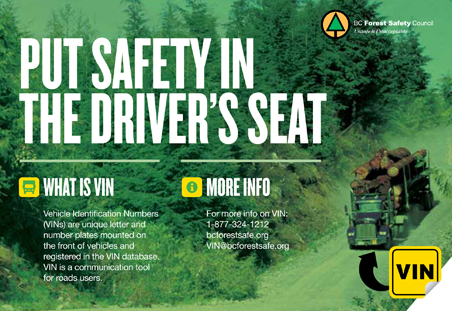 |
With the forest industry long being the cornerstone of economic activity in the province and the foundation of the province's economy, a massive network of roads comprising over 400,000 km of Forest Service Roads has been constructed to facilitate the transportation of products to market. |
An additional 250,000 km of Petroleum Development Roads, private roads, non-status roads, wilderness roads, spur roads, and permit roads fill out the "Resource Road" network. By comparison, the public highway network represents only about 47,000 km of road. |
The rules-of-the-road on this network are not the same as the public network, as industrial vehicles always have the right-of-way, while the quality of a road is only maintained to an industrial standard, which is much lower than a public highway. Larger industrial vehicles are also expected to radio ahead their position so as to avoid any mishaps with other industrial vehicles coming in the other direction. |
The VIN plates are intended to improve communication and self-policing amongst Resource Road users by providing a more legible plate than the standard provincial issue (be it the commercial or logging truck type). |
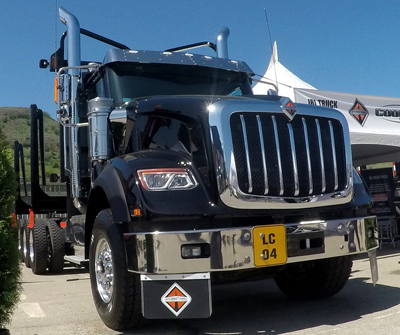 |
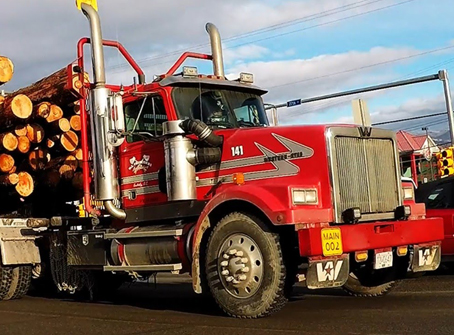 |
While the photos above show typical VIN plates that conform to the Forestry Safety Council's standards (i.e. black-on-yellow colour scheme), the examples below show that variations in these plates do exist with a black-on-white colour scheme used by some operators and with a greater differential between in size between letters and numbers. |
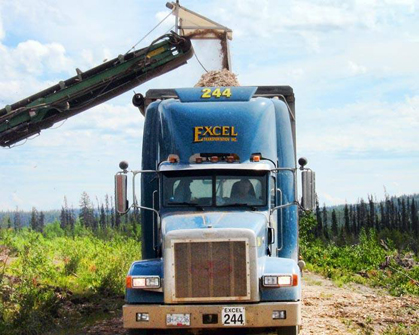 |
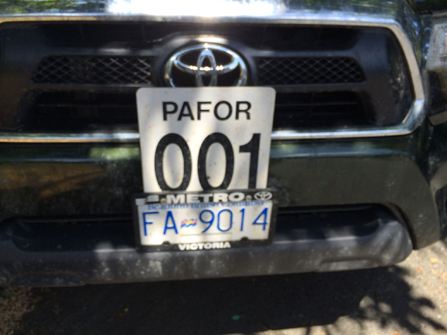 |
Apparently, the Safety Council considers the genesis of the VIN program to have been plates required by the Village of Slocan sometime in the late 1990’s — which may be the case — but local collectors believe the origins of this type of supplemental plate to be the forestry roads found on Vancouver Island in the 1960s. |
As anyone familiar with the collection amassed by Len Garrison (388) knows, it is not unusual to occasionally find notes written on masking tape on the back of a plate. Following Len's passing, a fairly non-descript, standard 12" x 6" yellow-on-black plate displaying only the No. "PR-184" surfaced with just such a note proclaiming "Private Road McNeil Logging Van. Island". "McNeil" is thought to be a reference to Port McNeill, which is a logging community located at the north end of the island. |
At left the "PR-184" plate (top) along with the hand written note on the back regarding its origin/purpose (bottom). The plate displays classic Oakalla Prison Shop dies and likely was made on contract for one of the forestry outfits in the Port McNeill area. Bob Dingsdale, a long-time trucker on the Island, was subsequently able to confirm that "PR" stands for Private Road and that these types of plates were common at the north end of Vancouver Island. |
|
The use of these Private Roads plates is thought to have faded out with the introduction of the Special Agreement plates in the early 1970s. Regardless, a number of these types of plates, includding a few specimens survive:. |
Private Road Plates |
|||
Quick Links: |
Antique | APEC | BC Parks | Chauffeur Badges | Collector | Commercial Truck | Consul | Dealer | Decals | Driver's Licences | Farm | Ham Radio | Industrial Vehicle | Keytags | Lieutenant Governor | Logging | Manufacturer | Medical Doctor | Memorial Cross | Motive Fuel | Motor Carrier | Motorcycle | Movie Props | Municipal | National Defence | Off-Road Vehicle | Olympics | Passenger | Personalized | Prorated | Prototype | Public Works | Reciprocity | Repairer | Restricted | Sample | Special Agreement | Temporary Permits | Trailer | Transporter | Veteran | VIN | Miscellaneous |
© Copyright Christopher John
Garrish. All rights reserved.












